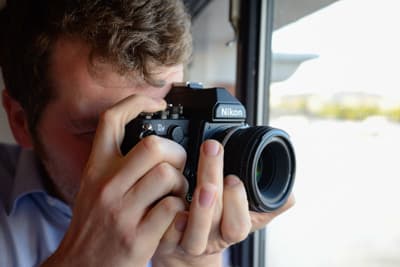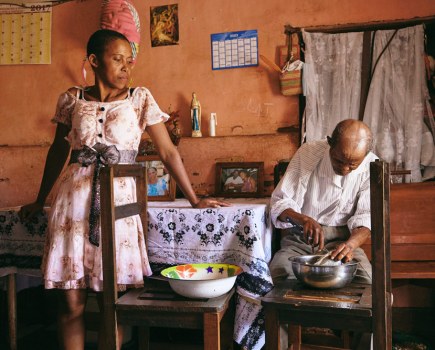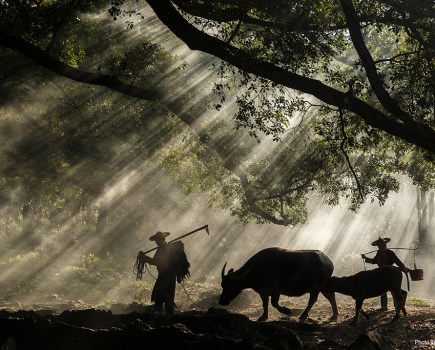
AP’s Technical Editor, Richard Sibley, with the new Nikon DF
UPDATED: Read our news story on the release of the Nikon Df
Described by Nikon as a celebration of photography, the new Nikon DF is designed with as much about the process and experience of taking photographs, as it is the images themselves. With this in mind the new camera harks back to classic Nikon F series SLR cameras, particularly the Nikon FM2. More of a subtle nod to the past is the use of the old style Nikon logo on the front of the cameras prism.
Named the DF, the new camera is a Digital Fusion of a classic SLR style merged with the latest technology, designed to appeal to photography enthusiasts and professionals alike.
Features
With the same full frame 16.2-million-pixel CMOS sensor as the Nikon D4, the Df should perform extremely well in low light conditions, especially with a sensitivity range of between ISO 100-12,800, which can be extended to a staggering ISO 50-204,800. The camera employs the latest Expeed 3 image processing, and it has a shutter that has been specifically designed for the camera. This shutter has been tested to have a lifespan of 150k actuations, on par with its premium, professional, status.
The sensor unit of the Nikon Df
Its shooting rate of 5.5fps is reasonable, without being exceptional, but this camera isn’t about action photography. That said the Multicam 48 AF system has 39 AF points, including 9 cross-type points and 7 points that are sensitive down to f/8. As we have seen in other recent Nikon DSLR cameras, the DF has a 2016 metering and white balance sensor, and it also inherits a 921k dot screen, featuring reinforced glass, as featured on other Nikon cameras.
In terms of connectivity the DF has HDMI output that can show a live view from the camera on an external screen. Wifi connectivity is made possible through the use of the Nikon WU-1a wifi accessory, and the hotshoe and flash can be used with Nikon wireless Creative Lighting flash system.
Whilst the feature set of the Nikon DF is important, it will be the build and handling that will be the biggest selling point for many photographers. It is certainly what has led to the DF being one of the most rumoured and anticipated camera of the last few years.
Build and Handling
Built from magnesium alloy and with the same weather and dust sealing as the Nikon D800, the DF is more than just a expensive novelty, retro-styled camera. For documentary and street photographers, even photo-journalists, it is a serious tool with the professional build quality you would expect.

In hand the camera feels solid and well built. There is a light handgrip on the front of the camera, enough to grip, but not enough to really wrap your hand around like you would with more contemporary styled DSLR.

What is perhaps surprising is the size of the camera. Based on the online teaser videos it has been difficult to get a real grasp of the size of the camera, and the truth is that it perhaps isn’t as small as many people have been expecting. It is obviously the smallest and lightest camera in the Nikon range of FX series cameras, but weighing 710g body only, it is only 50g lighter than the Nikon D610, and its footprint isn’t that much smaller.

What is most obvious about the cameras design is of course the number of dials on the cameras top plate. The top LCD panel has been shrunk dramatically and is a mere slither that just shows the exposure settings, current battery life and shot count. In place of a large LCD are an arrangement of dials designed to make changing the key exposure settings as tactile as possible.

There is a shutter speed dial, which also has a 1/3EV setting. Using this setting allows the rear control dial to change the shutter speed at 0.3Ev intervals rather than the full 1EV stops found on the shutter speed dial. On the left of the top plate is a ISO sensitivity dial, with a exposure compensation dial sat above it. These dials really give the feeling of using a film camera, perhaps more than any other DSLR that I have used. The noise of the shutter and clicks of the various exposure setting dials certainly add to the experience of using the DF. However, although the locks on the dials mean that they wont get accidentally nudged, they may hinder the speed at which settings can be adjusted.

With a pentaprism giving the viewfinder a bright, and clear, 100% field of view, I found that manual focusing was as easy with a D4 or D800, and the circular rubber viewfinder eye-piece is also as comfortable.
Lens Compatibility
Firstly, and it may only be a small thing, the DF can be used with pre 1977 Non-Ai lenses. For the unaware, Non-Ai (often referred to as Pre-Ai) lenses don’t have a Meter coupling ridge around the rear of the lens barrel. This ridge pushes against a lens indexing post that can be found around the lens mount of many Nikon SLRs. It tells the camera the maximum aperture of the attached lens for metering purposes. Mounting a Non-Ai lens on to a camera that has a indexing post can cause damage to the post and/or the lens. Ingeniously Nikon have deviced a way that the post can be folded back in to the camera to prevent damage, meaning that those with, unconverted, original Non-Ai lenses can use their lenses freely on the DF.
In fact Nikon claim that all but 2-3 or lenses they have launched will work on the DF. Those that don’t are the scarce lenses that required a Nikon SLRs mirror to be locked-up before mounting the lens. So to all intent and purposes, if you have one of the 80million manual or autofocus Nikkor F mount lenses made since 1959 it should work on the DF.

New Lens
To accompany the DF is a redesigned version of the Nikkor 50mm f/1.8 G lens. The new lens has the same optical design as the existing version, but with slightly retro design befitting the look of the camera, and a larger, knurled, rubberised manual focusing ring to assist manual focusing.
Battery Life
The EN-EL14a battery used by the Nikon DF is capable of powering the camera for 1,400 shots. That is extremely impressive and thanks to the power efficiency of the camera it can shoot more images than the D800. This adds to the portability of the DF, meaning that most people can go out for a day, a long weekend, even a week, without having to take the cameras battery charger. At worst a second battery is probably the only requirement that all but the most eager photographer will need on there travels.

AP’s Technical Editor, Richard Sibley, with the new Nikon DF
Initial Impressions
The Nikon DF looks the part, and from having it in my hands and firing a few shots, it certainly seems to handle well, and the viewfinder is excellent. There are a few questions that need to be answered. For many the choice of the 16.2-million-pixel D4 sensor, rather than the 36.4 million-pixel of the D800, or even the 24-million-pixel sensor used in the D610 is an odd one. Of course it provides superb image quality in low light with excellent noise performance, but in terms of resolution both the Sony Alpha 7 and 7R will potentially be better.
The camera is also a little larger than many were expecting, though it is of course smaller than any other full frame DSLR, the Alpha 7 cameras have full frame sensors and are also smaller.
And finally comes the cost of the camera. Although I have no doubt that the DF will sell exceptionally well, at £2749 it is quite expensive when, once again, it is compared to the body only price of the Alpha 7R – it is around £1000 more expensive.
With all of that said, the Nikon DF looks like it will be the DSLR that ‘works like an old FM2’, as many enthusiast photographers have wished for over the years. I can’t wait to put a few vintage manual focus lenses on it and see just how good it is. It certainly looks though Nikon has ticked all the right boxes.
The Nikon DF is due to go on sale on 28th November priced at £2749.99 with the 50mm f/1.8 lens. At present Nikon have said that there are no plans to release the camera for sale in a body-only version.











